+ Open data
Open data
- Basic information
Basic information
| Entry | Database: EMDB / ID: EMD-22591 | |||||||||
|---|---|---|---|---|---|---|---|---|---|---|
| Title | Structure of Secretory IgM Core | |||||||||
 Map data Map data | Secretory IgM Core | |||||||||
 Sample Sample |
| |||||||||
 Keywords Keywords | Immunoglobulin M / IMMUNE SYSTEM | |||||||||
| Function / homology |  Function and homology information Function and homology informationhexameric IgM immunoglobulin complex / polymeric immunoglobulin receptor activity / immunoglobulin transcytosis in epithelial cells mediated by polymeric immunoglobulin receptor / polymeric immunoglobulin binding / dimeric IgA immunoglobulin complex / IgM B cell receptor complex / secretory dimeric IgA immunoglobulin complex / pentameric IgM immunoglobulin complex / monomeric IgA immunoglobulin complex / secretory IgA immunoglobulin complex ...hexameric IgM immunoglobulin complex / polymeric immunoglobulin receptor activity / immunoglobulin transcytosis in epithelial cells mediated by polymeric immunoglobulin receptor / polymeric immunoglobulin binding / dimeric IgA immunoglobulin complex / IgM B cell receptor complex / secretory dimeric IgA immunoglobulin complex / pentameric IgM immunoglobulin complex / monomeric IgA immunoglobulin complex / secretory IgA immunoglobulin complex / Fc receptor signaling pathway / IgA binding / pre-B cell allelic exclusion / detection of chemical stimulus involved in sensory perception of bitter taste / IgM immunoglobulin complex / glomerular filtration / CD22 mediated BCR regulation / azurophil granule membrane / receptor clustering / immunoglobulin complex, circulating / immunoglobulin receptor binding / positive regulation of respiratory burst / humoral immune response / Scavenging of heme from plasma / complement activation, classical pathway / antigen binding / Antigen activates B Cell Receptor (BCR) leading to generation of second messengers / Cell surface interactions at the vascular wall / B cell receptor signaling pathway / epidermal growth factor receptor signaling pathway / antibacterial humoral response / protein-macromolecule adaptor activity / protein-containing complex assembly / defense response to Gram-negative bacterium / blood microparticle / adaptive immune response / Potential therapeutics for SARS / receptor complex / immune response / innate immune response / Neutrophil degranulation / cell surface / protein homodimerization activity / extracellular space / extracellular exosome / extracellular region / plasma membrane Similarity search - Function | |||||||||
| Biological species |  Homo sapiens (human) Homo sapiens (human) | |||||||||
| Method | single particle reconstruction / cryo EM / Resolution: 3.3 Å | |||||||||
 Authors Authors | Kumar N / Arthur CP | |||||||||
 Citation Citation |  Journal: Structure / Year: 2021 Journal: Structure / Year: 2021Title: Structure of the human secretory immunoglobulin M core. Authors: Nikit Kumar / Christopher P Arthur / Claudio Ciferri / Marissa L Matsumoto /  Abstract: Immunoglobulins (Ig) A and M are the only human antibodies that form oligomers and undergo transcytosis to mucosal secretions via the polymeric Ig receptor (pIgR). When complexed with the J-chain (JC) ...Immunoglobulins (Ig) A and M are the only human antibodies that form oligomers and undergo transcytosis to mucosal secretions via the polymeric Ig receptor (pIgR). When complexed with the J-chain (JC) and the secretory component (SC) of pIgR, secretory IgA and IgM (sIgA and sIgM) play critical roles in host-pathogen defense. Recently, we determined the structure of sIgA-Fc which elucidated the mechanism of polymeric IgA assembly and revealed an extensive binding interface between IgA-Fc, JC, and SC. Despite low sequence identity shared with IgA-Fc, IgM-Fc also undergoes JC-mediated assembly and binds pIgR. Here, we report the structure of sIgM-Fc and carryout a systematic comparison to sIgA-Fc. Our structural analysis reveals a remarkably conserved mechanism of JC-templated oligomerization and SC recognition of both IgM and IgA through a highly conserved network of interactions. These studies reveal the structurally conserved features of sIgM and sIgA required for function in mucosal immunity. | |||||||||
| History |
|
- Structure visualization
Structure visualization
| Movie |
 Movie viewer Movie viewer |
|---|---|
| Structure viewer | EM map:  SurfView SurfView Molmil Molmil Jmol/JSmol Jmol/JSmol |
| Supplemental images |
- Downloads & links
Downloads & links
-EMDB archive
| Map data |  emd_22591.map.gz emd_22591.map.gz | 226.6 MB |  EMDB map data format EMDB map data format | |
|---|---|---|---|---|
| Header (meta data) |  emd-22591-v30.xml emd-22591-v30.xml emd-22591.xml emd-22591.xml | 14.1 KB 14.1 KB | Display Display |  EMDB header EMDB header |
| Images |  emd_22591.png emd_22591.png | 106.1 KB | ||
| Filedesc metadata |  emd-22591.cif.gz emd-22591.cif.gz | 6.1 KB | ||
| Archive directory |  http://ftp.pdbj.org/pub/emdb/structures/EMD-22591 http://ftp.pdbj.org/pub/emdb/structures/EMD-22591 ftp://ftp.pdbj.org/pub/emdb/structures/EMD-22591 ftp://ftp.pdbj.org/pub/emdb/structures/EMD-22591 | HTTPS FTP |
-Validation report
| Summary document |  emd_22591_validation.pdf.gz emd_22591_validation.pdf.gz | 610.3 KB | Display |  EMDB validaton report EMDB validaton report |
|---|---|---|---|---|
| Full document |  emd_22591_full_validation.pdf.gz emd_22591_full_validation.pdf.gz | 609.8 KB | Display | |
| Data in XML |  emd_22591_validation.xml.gz emd_22591_validation.xml.gz | 7.1 KB | Display | |
| Data in CIF |  emd_22591_validation.cif.gz emd_22591_validation.cif.gz | 8.3 KB | Display | |
| Arichive directory |  https://ftp.pdbj.org/pub/emdb/validation_reports/EMD-22591 https://ftp.pdbj.org/pub/emdb/validation_reports/EMD-22591 ftp://ftp.pdbj.org/pub/emdb/validation_reports/EMD-22591 ftp://ftp.pdbj.org/pub/emdb/validation_reports/EMD-22591 | HTTPS FTP |
-Related structure data
| Related structure data |  7k0cMC M: atomic model generated by this map C: citing same article ( |
|---|---|
| Similar structure data |
- Links
Links
| EMDB pages |  EMDB (EBI/PDBe) / EMDB (EBI/PDBe) /  EMDataResource EMDataResource |
|---|---|
| Related items in Molecule of the Month |
- Map
Map
| File |  Download / File: emd_22591.map.gz / Format: CCP4 / Size: 244.1 MB / Type: IMAGE STORED AS FLOATING POINT NUMBER (4 BYTES) Download / File: emd_22591.map.gz / Format: CCP4 / Size: 244.1 MB / Type: IMAGE STORED AS FLOATING POINT NUMBER (4 BYTES) | ||||||||||||||||||||||||||||||||||||||||||||||||||||||||||||||||||||
|---|---|---|---|---|---|---|---|---|---|---|---|---|---|---|---|---|---|---|---|---|---|---|---|---|---|---|---|---|---|---|---|---|---|---|---|---|---|---|---|---|---|---|---|---|---|---|---|---|---|---|---|---|---|---|---|---|---|---|---|---|---|---|---|---|---|---|---|---|---|
| Annotation | Secretory IgM Core | ||||||||||||||||||||||||||||||||||||||||||||||||||||||||||||||||||||
| Projections & slices | Image control
Images are generated by Spider. | ||||||||||||||||||||||||||||||||||||||||||||||||||||||||||||||||||||
| Voxel size | X=Y=Z: 1.2 Å | ||||||||||||||||||||||||||||||||||||||||||||||||||||||||||||||||||||
| Density |
| ||||||||||||||||||||||||||||||||||||||||||||||||||||||||||||||||||||
| Symmetry | Space group: 1 | ||||||||||||||||||||||||||||||||||||||||||||||||||||||||||||||||||||
| Details | EMDB XML:
CCP4 map header:
| ||||||||||||||||||||||||||||||||||||||||||||||||||||||||||||||||||||
-Supplemental data
- Sample components
Sample components
-Entire : Structure of the Human Secretory Immunoglobulin M Core
| Entire | Name: Structure of the Human Secretory Immunoglobulin M Core |
|---|---|
| Components |
|
-Supramolecule #1: Structure of the Human Secretory Immunoglobulin M Core
| Supramolecule | Name: Structure of the Human Secretory Immunoglobulin M Core type: complex / ID: 1 / Parent: 0 / Macromolecule list: all |
|---|---|
| Source (natural) | Organism:  Homo sapiens (human) Homo sapiens (human) |
| Molecular weight | Theoretical: 480 kDa/nm |
-Macromolecule #1: Polymeric immunoglobulin receptor
| Macromolecule | Name: Polymeric immunoglobulin receptor / type: protein_or_peptide / ID: 1 / Number of copies: 1 / Enantiomer: LEVO |
|---|---|
| Source (natural) | Organism:  Homo sapiens (human) Homo sapiens (human) |
| Molecular weight | Theoretical: 65.154094 KDa |
| Recombinant expression | Organism:  |
| Sequence | String: KSPIFGPEEV NSVEGNSVSI TCYYPPTSVN RHTRKYWCRQ GARGGCITLI SSEGYVSSKY AGRANLTNFP ENGTFVVNIA QLSQDDSGR YKCGLGINSR GLSFDVSLEV SQGPGLLNDT KVYTVDLGRT VTINCPFKTE NAQKRKSLYK QIGLYPVLVI D SSGYVNPN ...String: KSPIFGPEEV NSVEGNSVSI TCYYPPTSVN RHTRKYWCRQ GARGGCITLI SSEGYVSSKY AGRANLTNFP ENGTFVVNIA QLSQDDSGR YKCGLGINSR GLSFDVSLEV SQGPGLLNDT KVYTVDLGRT VTINCPFKTE NAQKRKSLYK QIGLYPVLVI D SSGYVNPN YTGRIRLDIQ GTGQLLFSVV INQLRLSDAG QYLCQAGDDS NSNKKNADLQ VLKPEPELVY EDLRGSVTFH CA LGPEVAN VAKFLCRQSS GENCDVVVNT LGKRAPAFEG RILLNPQDKD GSFSVVITGL RKEDAGRYLC GAHSDGQLQE GSP IQAWQL FVNEESTIPR SPTVVKGVAG GSVAVLCPYN RKESKSIKYW CLWEGAQNGR CPLLVDSEGW VKAQYEGRLS LLEE PGNGT FTVILNQLTS RDAGFYWCLT NGDTLWRTTV EIKIIEGEPN LKVPGNVTAV LGETLKVPCH FPCKFSSYEK YWCKW NNTG CQALPSQDEG PSKAFVNCDE NSRLVSLTLN LVTRADEGWY WCGVKQGHFY GETAAVYVAV EERKAAGSRD VSLAKA DAA PDEKVLDSGF REIENKAIQD PRHHHHHH UniProtKB: Polymeric immunoglobulin receptor |
-Macromolecule #2: Immunoglobulin heavy constant mu
| Macromolecule | Name: Immunoglobulin heavy constant mu / type: protein_or_peptide / ID: 2 / Number of copies: 10 / Enantiomer: LEVO |
|---|---|
| Source (natural) | Organism:  Homo sapiens (human) Homo sapiens (human) |
| Molecular weight | Theoretical: 40.677605 KDa |
| Recombinant expression | Organism:  |
| Sequence | String: DYKDDDDKLE VLFQGPGSLP VIAELPPKVS VFVPPRDGFF GNPRKSKLIC QATGFSPRQI QVSWLREGKQ VGSGVTTDQV QAEAKESGP TTYKVTSTLT IKESDWLGQS MFTCRVDHRG LTFQQNASSM CVPDQDTAIR VFAIPPSFAS IFLTKSTKLT C LVTDLTTY ...String: DYKDDDDKLE VLFQGPGSLP VIAELPPKVS VFVPPRDGFF GNPRKSKLIC QATGFSPRQI QVSWLREGKQ VGSGVTTDQV QAEAKESGP TTYKVTSTLT IKESDWLGQS MFTCRVDHRG LTFQQNASSM CVPDQDTAIR VFAIPPSFAS IFLTKSTKLT C LVTDLTTY DSVTISWTRQ NGEAVKTHTN ISESHPNATF SAVGEASICE DDWNSGERFT CTVTHTDLPS PLKQTISRPK GV ALHRPDV YLLPPAREQL NLRESATITC LVTGFSPADV FVQWMQRGQP LSPEKYVTSA PMPEPQAPGR YFAHSILTVS EEE WNTGET YTCVVAHEAL PNRVTERTVD KSTGKPTLYN VSLVMSDTAG TCY UniProtKB: Immunoglobulin heavy constant mu |
-Macromolecule #3: Immunoglobulin J chain
| Macromolecule | Name: Immunoglobulin J chain / type: protein_or_peptide / ID: 3 / Number of copies: 1 / Enantiomer: LEVO |
|---|---|
| Source (natural) | Organism:  Homo sapiens (human) Homo sapiens (human) |
| Molecular weight | Theoretical: 15.611458 KDa |
| Recombinant expression | Organism:  |
| Sequence | String: QEDERIVLVD NKCKCARITS RIIRSSEDPN EDIVERNIRI IVPLNNRENI SDPTSPLRTR FVYHLSDLCK KCDPTEVELD NQIVTATQS NICDEDSATE TCYTYDRNKC YTAVVPLVYG GETKMVETAL TPDACYPD UniProtKB: Immunoglobulin J chain |
-Experimental details
-Structure determination
| Method | cryo EM |
|---|---|
 Processing Processing | single particle reconstruction |
| Aggregation state | particle |
- Sample preparation
Sample preparation
| Concentration | 0.2 mg/mL | |||||||||
|---|---|---|---|---|---|---|---|---|---|---|
| Buffer | pH: 7.2 Component:
| |||||||||
| Grid | Model: UltrAuFoil R0.6/1 / Material: GOLD / Mesh: 300 / Support film - Material: CARBON / Support film - topology: HOLEY / Support film - Film thickness: 2.5 / Pretreatment - Type: GLOW DISCHARGE / Pretreatment - Time: 5 sec. | |||||||||
| Vitrification | Cryogen name: ETHANE / Chamber humidity: 100 % / Chamber temperature: 277 K / Instrument: FEI VITROBOT MARK IV Details: Blot for 3.5 seconds before plunging with blot force 7.. | |||||||||
| Details | Sample was monodisperse. |
- Electron microscopy
Electron microscopy
| Microscope | FEI TITAN KRIOS |
|---|---|
| Image recording | Film or detector model: GATAN K2 SUMMIT (4k x 4k) / Detector mode: COUNTING / Average exposure time: 0.2 sec. / Average electron dose: 1.02 e/Å2 |
| Electron beam | Acceleration voltage: 300 kV / Electron source:  FIELD EMISSION GUN FIELD EMISSION GUN |
| Electron optics | Illumination mode: FLOOD BEAM / Imaging mode: BRIGHT FIELD / Cs: 2.7 mm / Nominal magnification: 165000 |
| Sample stage | Specimen holder model: FEI TITAN KRIOS AUTOGRID HOLDER / Cooling holder cryogen: NITROGEN |
| Experimental equipment |  Model: Titan Krios / Image courtesy: FEI Company |
- Image processing
Image processing
| Startup model | Type of model: NONE |
|---|---|
| Final reconstruction | Applied symmetry - Point group: C1 (asymmetric) / Resolution.type: BY AUTHOR / Resolution: 3.3 Å / Resolution method: FSC 0.143 CUT-OFF / Software - Name: cisTEM / Number images used: 244123 |
| Initial angle assignment | Type: ANGULAR RECONSTITUTION / Software - Name: cisTEM |
| Final angle assignment | Type: ANGULAR RECONSTITUTION |
 Movie
Movie Controller
Controller







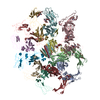
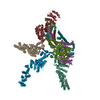



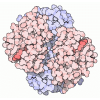



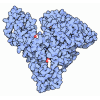

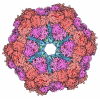

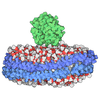




 Z (Sec.)
Z (Sec.) Y (Row.)
Y (Row.) X (Col.)
X (Col.)





















